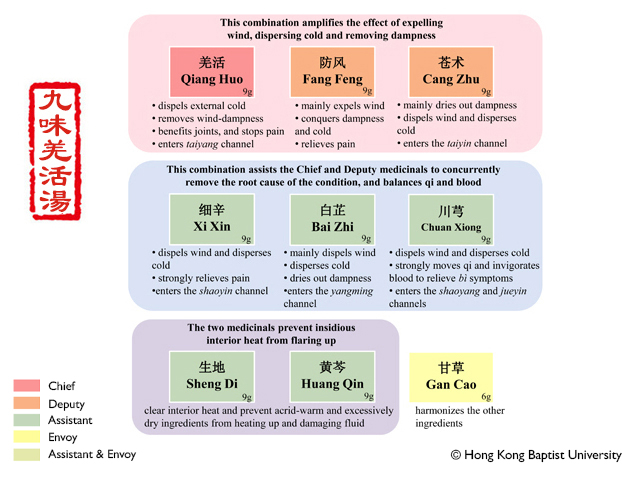NameNine Ingredients Notopterygium Decoction
ClassificationExterior-releasing formulas
CombinationNotopterygii Rhizoma et Radix (Qiang Huo) 1.5 liang (9g), Saposhnikoviae Radix (Fang Feng) 1.5 liang (9g), Atractylodis Rhizoma (Cang Zhu) 1.5 liang (9g), Asari Radix et Rhizoma (Xi Xin) 5 fen (3g), Chuanxiong Rhizoma (Chuan Xiong) 1 liang (6g), Angelicae Dahuricae Radix (Bai Zhi) 1 liang (3g), Rehmanniae Radix (Sheng Di Huang) 1 liang (6g), Scutellariae Radix (Huang Qin) 1 liang (6g), Glycyrrhizae Radix et Rhizoma (Gan Cao) 1 liang (6g)
MethodPrepare Jiu Wei Qiang Huo Tang as a decoction. The source book recommends coarsely grinding the ingredients before decocting the formula. If there is a therapeutic need to promote sweating urgently it should be taken warm followed by warm porridge to supplement the formula’s actions. Otherwise, if mild sweating is observed then it is taken warm without the porridge.
ActionInduces sweating, expels dampness, and clears internal heat.
IndicationJiu Wei Qiang Huo Tang is indicated for an exterior pattern with externally contracted wind-cold-dampness complicated by interior heat. The symptoms are aversion to cold, fever, absence of sweating, headache, painful stiff nape, pain and soreness of the limbs and body, bitter taste, and thirst. The tongue coating is white or light yellow, and the pulse is superficial or superficial and tight.
PathogenesisWhen wind-cold-dampness pathogens attack the skin and superficial muscles, wei yang becomes trapped and the striae becomes tightened and closed. The channels get obstructed and there is congestion of qi and blood. Therefore, there is aversion to cold, fever, absence of sweat, headache and painful stiff nape, and general body aches. Interior heat causes bitter taste and slight thirst. The tongue coating is white or light yellow with a superficial pulse. All of these are clear indications of an exterior pattern complicated by interior heat. The treatment should emphasize dispelling wind-cold-dampness pathogens and clearing interior heat.
Clarification1. Treatment based on channel differentiation : Up until approximately the Song or Yuan Dynasty, exterior patterns were treated as taiyang pattern conditions based on the Taiyang Chapters of Zhang Zhong-jing’s book. Although the taiyang channel is the first to be affected when external wind-cold and dampness pathogens attack the body, all six channels can be impacted. In this formula, qiang huo enters the taiyang channel, cang zhu enters the taiyin, xi xin enters the shaoyin, chuan xiong enters the jueyin, bai zhi enters the yangming, and huang qin enters the shaoyang. This combination takes care of both the exterior and the interior with several medicinals gravitating towards specific channels. Because of this, the source book emphasizes that “although nine medicinals make up one formula, the quantity of each medicinal should not be fixed in amount”; rather, a physician “needs to investigate the facts such as the sequence of the channels affected, on which side, the number of channels, and the range and severity, in order to modify the amount of each ingredient being used in the prescription” . This is the only way to reach a “marvelous effect” . In modern applications, use a larger quantity of qiang huo if the headache affects the occipital area, bai zhi if it affects the forehead, chuan xiong if it affects the temporal regions and xi xin if it extends into the mouth causing toothache.
Application1. Essential pattern differentiation This formula is commonly indicated for the pattern characterized by externally contracted wind-cold-dampness complicated by interior heat, and also a representative formula for the principle of “treatment based on channel differentiation”. Key signs and symptoms for pattern differentiation include: aversion to cold, fever, headache, absence of perspiration, aching and soreness of the limbs and body, bitter taste, and slight thirst. 2. Modern applications This formula may be used in biomedically defined disorders such as the common cold, acute myositis, rheumatic arthritis, migraine headache and lumbar muscle degeneration when the patient shows signs and symptoms of exterior wind-cold-dampness pattern complicated with interior heat. 3. Cautions and contraindications Although Jiu Wei Qiang Huo Tang contains cold natured sheng di huang and huang qin, it is overall an acrid-warm, drying therapy. Consequently, it is not applicable for patients suffering neither an externally contracted wind-heat pattern nor a yin deficiency with an internal heat pattern.
Additonal formulaeDa Qiang Huo Tang (Major Notopterygium Decoction, 大羌活湯)
Source《A formula of Zhang Yuan-su》Zhang Yuan Su Fang《張元素方》recorded in《The Bewildering Matter》Ci Shi Nan Zhi《此事難知》
